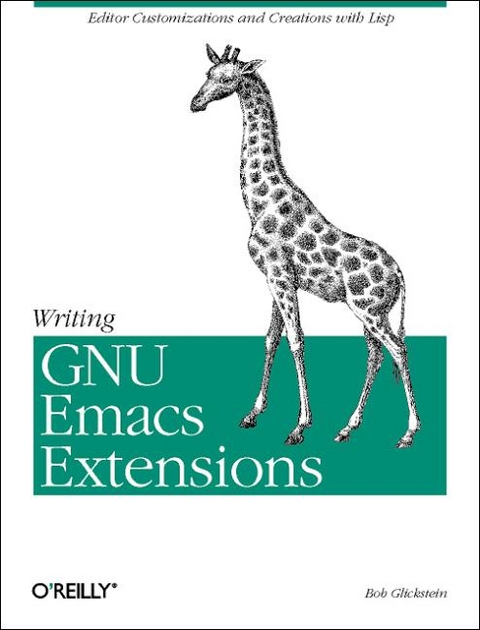
Writing GNU Emacs Extensions
O'Reilly Media (Verlag)
978-1-56592-261-7 (ISBN)
- Titel ist leider vergriffen;
keine Neuauflage - Artikel merken
Yes, it is possible to be all things to all people, if you're talking about the Emacs editor. As a user, you can make any kind of customization you want, from choosing the keystrokes that invoke your favorite commands to creating a whole new work environment that looks like nothing ever developed before. It's all in Emacs Lisp -- and in this short but fast-paced book. GNU Emacs is more than an editor; it's a programming environment, a communications package, and many other things. To provide such a broad range of functions, it offers a full version of the Lisp programming language -- something much more powerful than the little macro languages provided in other editors (including older versions of Emacs). GNU Emacs is a framework in which you can create whole new kinds of editors or just alter aspects of the many functions it already provides. In this book, Bob Glickstein delves deep into the features that permit far-reaching Emacs customizations. He teaches you the Lisp language and discusses Emacs topics (such as syntax tables and macro templates) in easy-to-digest portions. Examples progress in complexity from simple customizations to extensive major modes.
You will learn how to write interactive commands, use hooks and advice, perform error recovery, manipulate windows, buffers, and keymaps, exploit and alter Emacs's main loop, and more. Each topic is explored through realistic examples and a series of successive refinements that illustrate not only the Emacs Lisp language, but the development process as well, making learning pleasant and natural.
Bob Glickstein's dog, Alex, says Bob is generous with treats and takes her to the park a lot. Alex remembers the time in the mid- to late 1980s when Bob was first exposed to Lisp at Carnegie Mellon University and created the Lisp-like filtering language FLAMES for the Andrew Message System. She is dimly aware of the way in which Bob's familiarity with Lisp helped him to overcome his initial dislike of Emacs, with the result that he is now an ardent Emacs advocate. Nowadays, she enjoys playing on the beaches and mountains of Northern California while Bob devises new ways to use Emacs for writing email software at Zanshin, Inc.
Preface 1. Customizing Emacs Backspace and Delete Lisp Keys and Strings To What Is C-h Bound? To What Should C-h Be Bound? Evaluating Lisp Expressions Apropos 2. Simple New Commands Traversing Windows Line-at-a-Time Scrolling Other Cursor and Text Motion Commands Clobbering Symbolic Links Advised Buffer Switching Addendum: Raw Prefix Argument 3. Cooperating Commands The Symptom A Cure Generalizing the Solution 4. Searching and Modifying Buffers Inserting the Current Time Writestamps Modifystamps 5. Lisp Files Creating a Lisp File Loading the File Compiling the File eval-after-load Local Variables Lists Addendum: Security Consideration 6. Lists The Simple View of Lists List Details Recursive List Functions Iterative List Functions Other Useful List Functions Destructive List Operations Circular Lists?! 7. Minor Mode Paragraph Filling Modes Defining a Minor Mode Mode Meat 8. Evaluation and Error Recovery limited-save-excursion eval Macro Functions Backquote and Unquote Return Value Failing Gracefully Point Marker 9. A Major Mode My Quips File Major Mode Skeleton Changing the Definition of a Paragraph Quip Commands Keymaps Narrowing Derived Modes 10. A Comprehensive Example New York Times Rules Data Representation User Interface Setting Up the Mode Tracking Unauthorized Changes Parsing the Buffer Word Finder Last Word Conclusion A. Lisp Quick Reference Basics Data Types Control Structures Code Objects B. Debugging and Profiling Evaluation The Debugger Edebug The Profiler C. Sharing Your Code Preparing Source Files Documentation Copyright Posting D. Obtaining and Building Emacs Availability of Packages Unpacking, Building, and Installing Emacs Index
| Erscheint lt. Verlag | 6.5.1997 |
|---|---|
| Verlagsort | Sebastopol |
| Sprache | englisch |
| Maße | 178 x 229 mm |
| Gewicht | 440 g |
| Einbandart | kartoniert |
| Themenwelt | Informatik ► Betriebssysteme / Server ► Unix / Linux |
| Mathematik / Informatik ► Informatik ► Programmiersprachen / -werkzeuge | |
| ISBN-10 | 1-56592-261-1 / 1565922611 |
| ISBN-13 | 978-1-56592-261-7 / 9781565922617 |
| Zustand | Neuware |
| Informationen gemäß Produktsicherheitsverordnung (GPSR) | |
| Haben Sie eine Frage zum Produkt? |
aus dem Bereich


